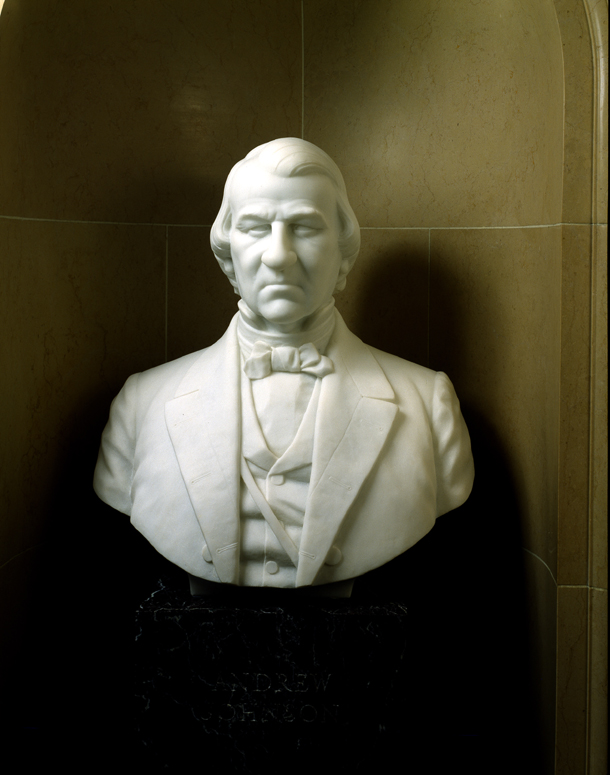
| Title | Andrew Johnson |
| Artist/Maker | William C. McCauslen ( 1860 - 1929 ) |
| Date | 1900 |
| Medium | Marble |
| Dimensions | h. 32 x w. 28.5 x d. 18.63 in. (h. 81.3 x w. 72.4 x d. 47.3 cm) |
| Credit Line | U.S. Senate Collection |
| Accession Number | 22.00016.000 |
For the Senate’s Vice Presidential Bust Collection, Andrew Johnson’s daughter, Martha Johnson Patterson of Greeneville, Tennessee, reviewed photographs of various portrait models of her father. She selected one by sculptor William C. McCauslen of Washington, D.C.
In writing to Senator George Peabody Wetmore of Rhode Island, chairman of the Joint Committee on the Library, Patterson noted: “I am no critic, but think I am the best judge and hope my preferences will be considered.” In actuality, Johnson’s modest daughter, who was the wife of Senator David Trotter Patterson of Tennessee, had both an artistic eye and strong political credentials for such a task. During her father’s years in office, she served as White House hostess in place of her invalid mother. In 1866-67 the president’s daughter personally directed extensive remodeling and redecorating at the White House. While exploring the attic, she discovered a series of forgotten portraits of Presidents John Quincy Adams, Van Buren, Tyler, Polk, Fillmore and Pierce by famed portraitist George P.A. Healy. The series, commissioned by Congress in 1857, had been interrupted by the Civil War, with the completed but unframed paintings relegated to the attic. When Patterson showed her father her discovery, the delighted president secured an appropriation for framing the portraits. Patterson then had the works hung in the transverse hall on the state floor outside the state parlors in 1867.
Now, more than three decades later, the president’s daughter again exerted her influence. Her choice of the Ohio-born McCauslen was heeded. On February 23, 1900, Wetmore authorized McCauslen, who had already depicted Vice Presidents William R. King and John Tyler, to execute the bust of Andrew Johnson for the Senate’s memorial series.
Andrew Johnson, a U.S. representative and senator from Tennessee and vice president and president of the United States, was born in Raleigh, North Carolina. A tailor by trade, Johnson displayed a powerful speaking ability. His support of the working classes advanced a career in local and state politics. Johnson was elected to the U.S. House of Representatives in 1842 and, after serving as governor of Tennessee, was elected to the U.S. Senate in 1857. The only Southern senator who did not withdraw from Congress after the outbreak of the Civil War, Johnson introduced a successful Senate resolution declaring the war to be not an oppressive measure, but rather an action for the defense and maintenance of the Constitution and the Union.
Appointed military governor of Tennessee in 1862, Johnson kept the state under Union control after Northern victories at Forts Henry and Donelson, and at Shiloh. The National Union Convention nominated Johnson to be Abraham Lincoln's vice presidential running mate in 1864. Sworn in as the 16th vice president in March 1865, he became the 17th president of the United States six weeks later when Lincoln was assassinated. Johnson surprised many by adopting Lincoln's lenient Reconstruction policies. As a result he met with increasing congressional opposition from Radical Republicans, who demanded federal protection of the freedmen of the South. When Johnson suspended Secretary of War Edwin Stanton, the House of Representatives swiftly voted for the president's impeachment, charging that he had violated the Tenure of Office Act.
On March 5, 1868, the Senate convened as a court of impeachment to consider removing Johnson from the presidency. The effort failed by a single vote to achieve the two-thirds majority necessary to convict the president. Johnson did not run for reelection. After leaving office, he again became active in Tennessee politics. Although Johnson returned to the Senate in 1875, he died within months of taking office.